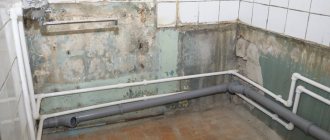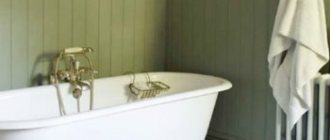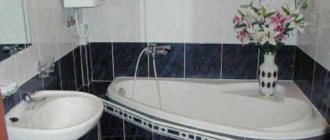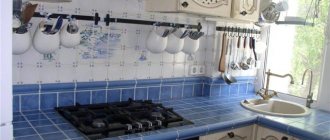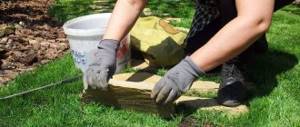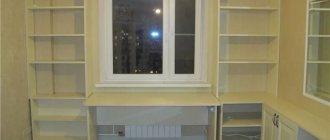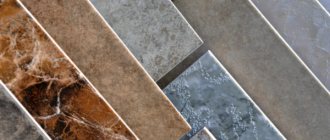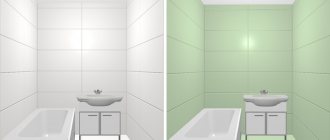Among the many modern finishing materials, tiles continue to be the most popular for bathroom renovations. Let's look at what ways there are to update a bathroom without replacing the tiles with new ones and how you can do it yourself. Most of these methods are quite simple and inexpensive, so carrying out this type of repair is not difficult.
Preparation
The first step to any renovation is to prepare the coating. Without a number of mandatory measures, the result will not be of sufficient quality. You need to act sequentially:
- First, you need to evaluate the tile covering for defects, chips, methods of elimination, and possible restoration options;
- Carry out restoration of seams, completely or partially replace grout;
- The surface of the tile must be brought into a perfectly clean condition, all traces, plaque, rust, and water stains must be removed;
- Degrease the surface using alcohol solutions and degreasers;
- Sand the glaze layer and uneven surfaces;
- Prime if necessary.
After all the preparatory work has been completed, proceed with the repairs. It is important to treat every area with high quality. If fungus appears on the walls, it would be a good idea to use antibacterial agents.
Before starting work, the walls need to be thoroughly dried. Any material will not fit well on a wet surface.
Wall decoration in the bathroom
The simplest and most common finishing option is plastic panels. They are very inexpensive, come in a variety of colors and are easy to install. Special preparation of walls is not necessary provided the plaster is in satisfactory condition. Even a novice creator of his own comfort can cope with such repairs. If you want to see classic tiles in your bathroom, but your budget is against it, you can choose panels that imitate tiles. PVC panels are easy to care for; you just need to wipe them occasionally with a damp cloth. But remember: to prevent fungus and mold from appearing under the finishing, it is better to treat the interpanel seams with sealant. Another disadvantage is that installing panels on the sheathing takes up to 5 cm from each side.
Scheme of finishing with plastic panels.
Painting the walls is also an inexpensive alternative to bathroom tiles. Just don’t rush to buy oil paint - this is the last century of design. Modern technologies offer latex. It is moisture resistant and with a variety of colors can surprise the most demanding designer. Painting walls with it is easy and reliable if you first level them and apply a special vapor barrier primer. 2-3 layers of applied paint will not emit a pungent odor.
Wooden lining, i.e. decorating the walls in the bathroom with narrow wooden planks looks very beautiful, but those who choose this tile alternative should remember that wood really does not like moisture. Therefore, before final installation, the lining must be thoroughly treated with an antiseptic.
Washable wallpaper is not the most durable material for decorating a bathroom, but it also has a right to exist. Vinyl or special wallpaper with fiberglass in its composition must be marked in the form of 3 waves on the packaging. They are glued to walls that have been previously leveled and treated with a moisture-resistant primer using antifungal glue. To prevent water from penetrating under the wallpaper and causing fungus to appear there, the joints between the strips must, as in the case of PVC panels, be secured with a transparent sealant.
Don’t forget about liquid wallpaper, which contains moisture-resistant components. They are very diverse and easy to use. Just buy a special plastic spatula along with the decorative material. This finish also requires special attention when choosing.
Bathroom ceiling installation diagram.
A foam ceiling slab can perfectly and originally replace a tiled one. First level the surface of the walls, then carefully lay out the tiles. Seal the seams. When installing such tiles in the bathroom, choose a smooth ceiling finish, otherwise there will be no harmony in the design. Foam tiles can be painted in any color - you get textured colored walls.
“Bark beetle” is a special plaster interspersed with large particles, which, when applied to the wall, form an original pattern, as if it had been treated with wood damaged by bark beetles. It is applied with a wide spatula; before application, the wall is leveled and primed. It is better to leave it for several days to harden in a humid room. After this you can paint the walls.
Cladding with artificial or natural stone is not a cheap pleasure. Usually the stone is laid out as a mosaic using a special moisture-resistant glue. In this case, the walls require perfect alignment. Instead of stone, you can use pieces of glass or mirror with a pattern printed on the back side, and finish, for example, only the corners or a door.
Coating repair
There can be many reasons to change the design of a bathtub: outdated design, desire for novelty, defective coatings. Repair and maintenance will bring the appearance of the bathroom to its original state. There are several ways to update old tiles without having to completely replace them.
Cracked tiles should be replaced where they occurred. This manipulation must be carried out with those parts that are cracked or peeled off. You need to act sequentially:
- Remove the grout around the element to be replaced;
- Moisten the seams with water and wait for the solution to soften;
- Using a spatula, remove the damaged part;
- Clean the area from any remaining glue;
- Prepare the fixing compound and treat the tiles with it;
- Secure in place;
- Rub the seams.
Using this principle, you can partially replace fragments and update the design. It is not at all necessary to choose exactly the same fragment; you can give preference to contrasts.
For restoration, you can clean the top layer, treat it with a primer, and paint it. Use film, appliqués, and other methods. There can be many ways to carry out repairs with your own hands, it all depends on taste, conditions, wishes, and budget.
Think about what exactly you want to see in your space, what budget you are willing to spend on making changes. This may determine whether it will be targeted growth or the creation of a mirror wall.
Grouting joints
How long does it take for the glue to dry? This is a frequently asked question. Drying depends on the brand of glue, but it is recommended to wait two days. After the glue has completely set, you can begin grouting the tile joints. The seams are rubbed using a rubberized spatula. Make sure that the joint is completely filled when grouting.
Remove excess two to three hours after grouting. Use sealant and apply it to the corners where the bathtub and wall meet, and attach a corner or apply curb tape to the top. There are various options for repairing and updating old tiles, but the most effective method is to remove and install new tiles.
Replacing bathroom tiles yourself
Vinyl tile stickers
A rather interesting method to restore the surface of a tile is to apply vinyl stickers. The method is characterized by low cost of materials, a wide selection of patterns, and easy application. The appearance of a room can be changed beyond recognition in a very short period of time.
You can show your imagination, change the entire tile, parts of the walls, create a mosaic effect, a certain pattern. The process is extremely simple, even those who have absolutely no experience in repair work can do it.
Mandatory conditions for reliable application are cleanliness, degreasing of the surface, and dryness. The most difficult task is to process the seams.
Material of this kind can vary quite significantly in cost and quality. Its price will also be influenced by the texture and pattern.
Using this simple method, you can easily create a waterfall on the wall and plunge yourself to the bottom of the Mediterranean Sea.
An additional advantage of such a film is that it is quite easy to remove. Once you get tired of the appearance, you can remove and apply a new design. The choice can be made between large-scale paintings and individual applications.
An alternative to tiles in the bathroom
Question author: Olga (March 23, 2017)
Question: An alternative to tiles in the bathroom Good afternoon, tell me, is there any alternative to tiles in the bathroom today? Thank you.
Answer:
Hello Olga. If you need an alternative to tiles in the bathroom, then we suggest considering several finishing options.
Any specialist will tell you that the most worthy replacement for tiles is mosaic. A variety of materials are used to make it: glass, ceramics, stone, wood and even metal. The variety of formats, designs and colors of this material is simply incredible, which allows you to choose the appropriate coating for your interior design. Thanks to the flexible base, the mosaic fits perfectly on almost any surface, hiding all the roughness and unevenness. The only thing that may confuse you is the high cost of cladding.
The walls in the bathroom can be painted. Previously, this was done using oil paints, but today a better and safer product has appeared - latex paint. It is waterproof, without a characteristic odor, and is sold in a wide range of colors. However, before applying it, it is necessary to carefully prepare the surface of the walls: level it, treat it with a vapor barrier primer.
Plastic panels are a good alternative to bathroom tiles. They also have good moisture resistance and are easy to care for daily. In appearance, they are very similar to small-format cladding coatings, but do not differ in the same strength and durability. Another important point: if the seams have not been additionally sealed, then fungus and mold may form behind the finishing of the panels. The advantages of this material are their relatively low cost and ease of installation.
Moisture-resistant wallpaper will also help replace tiles in the bathroom. It is better to give preference to samples with special markings in the form of three waves or use vinyl analogues. You will also need a moisture-resistant primer and glue containing antifungal components. The joints must be treated with silicone sealant. But, as practice shows, the best option is a combination of wallpaper with tiles or decorative panels, otherwise they will not last long.
The bathroom is often decorated using natural or artificial stone. The external and operational characteristics of this material are beyond praise, but the installation work is too labor-intensive, and not everyone can afford the cost.
And finally, glass or mirror slabs can be an alternative to tiles in the bathroom. For example, a holographic pattern is often applied to the back side of glass samples or multilayer coatings with a decorative layer are used. The price of such products is usually quite high.
Applying patterns
An interesting and original option to refresh the appearance of the tiles is to apply a pattern to the tiles. You can use paints for the work. The highest quality, original method is to paint the surface by hand. A specialist, a person with artistic abilities, can handle such work.
If this method is not possible, you should make a stencil. Using a stencil you can create almost any design. Paint will be used to apply it. You can even use tape, which can be used to make patterns geometric.
It is enough to seal those areas where paint should not be applied, and treat the rest. Before painting, the surface is treated with a primer. Once the primer has dried, you can begin applying color.
The paint can be used for cars, glass, ceramics, epoxy, oil, acrylic. The drawing must be secured with varnish.
The surface should first be cleaned, degreased, and dried.
Stencils can be purchased ready-made or made yourself. With their help, you can apply a pattern of one shade or several colors.
All you need to do is attach the stencil to the surface of the tile. Treat the surface free from the stencil with a primer. After drying, apply paint using a sponge, roller, brush, or aerosols. It is worth doing this manipulation several times.
Once the paint is completely dry, remove the stencil. Cover the surface with a clear, waterproof varnish.
Modern industry provides a huge range of paints, some of which can even change the texture of the material.
Complete painting without removing
One radical method to update the tiles in the bathroom without changing it is to completely paint it. Even with very high-quality work, the result will look quite simple.
In the case of such work, you need to paint the entire surface along with the seams. Paint must be applied using rollers and brushes. Those areas that are frequently exposed to steam may sag after a short period of time and should be left untreated.
We apply new paint to the areas near the sink, toilet, and floor. It is necessary to prepare the walls well before applying color. You can update the color scheme of individual areas. The tiles can be cleaned with sandpaper and primed. This way the enamel will stick better.
You should only choose specially designed types of dyes that are intended for this type of surface and are not afraid of moisture.
You can experiment with zoning rooms, use several colors, change the texture, emit stone, ivory, metal, bronze, gold. Be sure to secure the result with a layer of protective varnish.
Preparing for the main job
Before you start dismantling the old tiles, prepare the bathroom: remove the excess, cover the floor with oilcloth, and also protect the plumbing by covering it with a thick cloth, such as a blanket. If possible, it is advisable to dismantle the plumbing during the work.
When you start working, start from the top row, each tile is pryed with a chisel and removed from the surface. If the tile is glued well and does not separate, then simply break it with a hammer, then remove the pieces one by one. If you use a hammer drill, there is a risk of damaging the surface, which will create additional work. After completing this tap, thoroughly clean the surface of any old glue. The wall must be absolutely flat in order to properly fix the new layer of tiles.
Replacing bathroom tiles
Now you need to find out how smooth the surface is for laying the new layer. If you need to level the wall, prepare a solution and apply plaster. But to level the surface, you can also use plasterboard sheets, which is not as labor-intensive as when plastering a wall. The next stage is applying primer. For good adhesion, it is recommended to prime.
Do-it-yourself voluminous decor
You can effectively update your bathroom design with an original decorative element. You can get creative. Beads, shells, stones or faux moldings. They are placed pointwise or used for applications. When using them, first think about how you can take care of their cleanliness.
For decoration, you can use both natural elements and various imitations. It is convenient to attach them with waterproof glue, silicone, or sealant. In some cases, the surface of the product is pre-painted and coated with waterproof varnish.
Such details look interesting in certain corners. Surface decor around mirrors, individual walls, corners.
Renewing seams
In some cases, in order to change the appearance of the bathroom, it is enough to restore the grout between the tiles. Increased humidity and the penetration of dust and dirt into the pores lead over time to a change in the color of the seams and a sloppy appearance. You can change the shade using special pencils and solutions.
In some cases, such a procedure may not bring the desired result and one has to resort to much more complex manipulations.
Rules for cleaning damaged areas
If some grout gaps are crumbling or damaged by fungus, they should be replaced. The damaged area must be cleaned with a sharp object and any remaining contamination must be removed. Prime the cleaned areas and apply new grout.
Replacing damaged tiles
Local replacement of damaged areas of tile covering
It is clear that to replace a damaged tile you will need another one, and so that it does not spoil the appearance, it must be exactly the same. This is probably why some forward-thinking homeowners purchase tiles with a reserve. But what to do if there is no stock ? Calm down, there is a way out of even this situation.
The tile is damaged and needs to be replaced
You can go to the nearest construction market and pick up several decorative tiled or simple (depending on the model on your wall) modules of contrasting colors. A few inserts will not spoil it, but rather will add expressiveness. Even moreover, if these tiled modules are picturesque, like paintings, then they can transform the bathroom beyond recognition - how can one not remember the proverb - What doesn’t happen is for the better!
Such an insertion of a picturesque tile module in place of damaged tiles will significantly transform and revitalize the bathtub
Complete replacement
In some cases, the only correct way will be to completely replace the grout. Remove the old grout using a scraper. A special product will help cope with cement-based grout.
To replace the grout with a new one, eliminate all old residues, remove dust, and apply a new substance. Contrasting shades look good. You can add an admixture of glow composition to the grout, which will create an interesting design in the dark. End of form
Overlapping tiles with another material
Among the more radical methods of renovating a bathroom without removing the tiles is covering it with another material. You can cover the tiles with moisture-resistant panels. Another original option is to replace parts of the tiles. These can be arbitrary pieces or a specific area. A new color can be given to the tiles using putty, primer, or painting.
The use of mosaics, drawings, mirror surfaces, even entire walls will add freshness to the room. Combine painting with the use of panels, changing the structure, creating Venetian plaster, bark beetle. Floor tiles can be made three-dimensional, decorative elements can be laid out, filled with a layer of epoxy compound, and you can get 3 d floors.
Whatever restoration option you choose, consistent work, imagination, and a little work will help give new life to your bathroom.
Tile repair – where to start?
Repairing bathroom tiles is a process that requires care and attention. In this article, we will look at the components involved in restoring tiles in the bathroom. And also, in fact, how to change the tiles in the bathroom with your own hands.
Repairing tiles in the bathroom, for starters, includes preliminary work that involves preparing the surface for the tiles.
Before changing the tiles in the bathroom, you should clean the ceiling and walls of the previous coating.
Tile texture - wallpaper, brick, what to choose?
Removing old tiles
We change the tiles in the bathroom using special tools. For convenience, we recommend that you use a mechanical hammer drill (with a spatula attachment), a hair dryer (which softens the paint), a spatula, or even a chisel (with it you can easily update old tiles in the bathroom). After complete removal of the previous coating, the work surface should be treated before the next stage of restoring the tiles in the bathroom. To do this, just use a soap solution. The next stage of restoring tiles in the bathroom includes the process of priming with ordinary glue, which is diluted with water in a ratio of 1 to 1.
After which you can already install the door frame for future doors. If necessary, at the same stage, the procedure for leveling the ceiling surface is carried out - for which it is necessary to putty the surface. The last stage of the renovation is, in fact, replacing the tiles in the bathroom. Experienced professionals know how to update bathroom tiles without resorting to complex and expensive methods. For example, to prevent the tiles in the bathroom from cracking, the ceiling and walls must first be reinforced with a special mesh.
Installing bathroom doors
